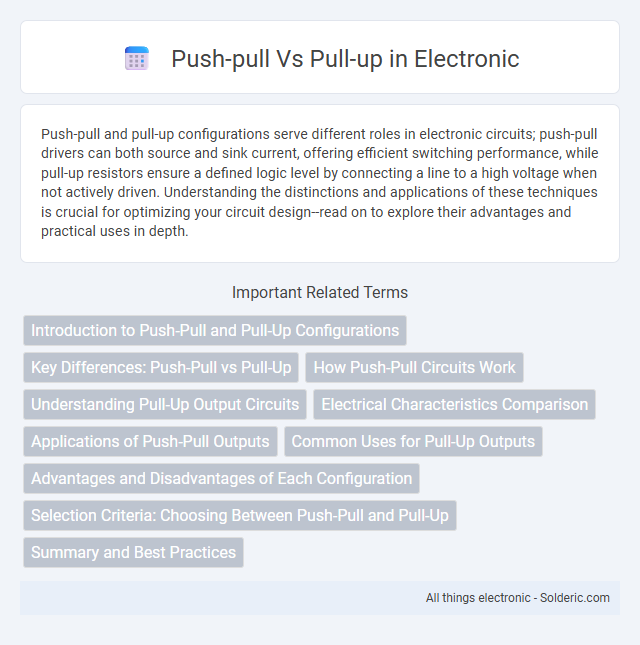Push-pull and pull-up configurations serve different roles in electronic circuits; push-pull drivers can both source and sink current, offering efficient switching performance, while pull-up resistors ensure a defined logic level by connecting a line to a high voltage when not actively driven. Understanding the distinctions and applications of these techniques is crucial for optimizing your circuit design--read on to explore their advantages and practical uses in depth.
Comparison Table
| Aspect | Push-Pull | Pull-Up |
|---|---|---|
| Definition | Output stage actively drives both high and low states. | Passive resistor pulls line to high when not driven. |
| Components | Two transistors (one sourcing, one sinking current). | Resistor connected to a positive voltage supply. |
| Power Consumption | Higher during switching due to both transistors. | Lower, resistor consumes power only when line is low. |
| Speed | Faster switching transitions. | Slower, depending on resistor and line capacitance. |
| Output Drive | Strong drive capability both high and low. | Strong drive low, weak passive pull high. |
| Use Cases | High-speed digital signals, low output impedance needed. | Open-drain/open-collector outputs, shared bus lines. |
| Complexity | More complex circuitry. | Simpler design. |
Introduction to Push-Pull and Pull-Up Configurations
Push-pull and pull-up configurations are fundamental techniques in digital electronics for controlling signal lines and interfacing with devices. Push-pull drivers actively drive the output both high and low, offering fast switching and strong drive capability suitable for high-speed signals. In contrast, pull-up resistors passively hold the line at a high voltage level when no device is actively pulling it low, ensuring defined logic states in open-collector or open-drain circuits.
Key Differences: Push-Pull vs Pull-Up
Push-pull configurations use two transistors to actively drive the output both high and low, providing faster switching speeds and better power efficiency. Pull-up circuits rely on a resistor to connect the output to a positive voltage, ensuring the line is high when no active device pulls it low, which simplifies design but results in slower transitions and higher power consumption. Understanding these key differences helps you select the appropriate method based on speed, power efficiency, and circuit complexity requirements.
How Push-Pull Circuits Work
Push-pull circuits operate by using two transistors that alternately drive current through a load, effectively providing both high and low voltage swings, which improves efficiency and reduces distortion. When one transistor pushes current into the load, the other pulls current away, ensuring a consistent and strong output signal. Your audio or power applications benefit from this design by achieving better power delivery and reduced heat generation compared to single-ended or pull-up resistor configurations.
Understanding Pull-Up Output Circuits
Pull-up output circuits use resistors connected between the output and the positive voltage supply to ensure a defined high logic level when the output transistor is off. These circuits rely on external components to pull the line to a high state, preventing floating inputs and ensuring signal integrity. Understanding pull-up configurations helps you design reliable digital interfaces by ensuring stable voltage levels and preventing erroneous logic states.
Electrical Characteristics Comparison
Push-pull and pull-up configurations differ significantly in electrical characteristics, where push-pull actively drives both high and low output states, resulting in faster switching speeds and reduced power consumption during state transitions. Pull-up circuits rely on a resistor to maintain a high level and require an external device to actively pull the line low, leading to slower rise times and increased static power dissipation. The push-pull arrangement achieves lower output impedance and better noise immunity compared to the higher impedance and susceptibility to voltage fluctuations inherent in pull-up designs.
Applications of Push-Pull Outputs
Push-pull outputs are commonly used in applications requiring rapid switching and strong drive capabilities, such as digital circuit interfacing, motor drivers, and LED displays. Their ability to actively drive both high and low states enables efficient signal transmission and reduced power consumption in switching regulators and microcontroller GPIO pins. Push-pull configurations excel in high-speed communication protocols like SPI and UART, where sharp signal transitions are critical.
Common Uses for Pull-Up Outputs
Pull-up outputs are commonly used in digital circuits to ensure a defined logic level when no active driver is present, preventing floating inputs that can cause unpredictable behavior. They are essential in open-drain or open-collector configurations, where multiple devices share a single communication line, such as I2C bus systems and button input interfaces. Your designs benefit from pull-up resistors by maintaining stable high states, enabling reliable signal detection and minimizing noise interference.
Advantages and Disadvantages of Each Configuration
Push-pull configurations provide high output drive capability and reduced power dissipation by using complementary transistors to actively drive both high and low states, resulting in faster switching speeds. However, they can suffer from crossover distortion and increased circuit complexity due to the need for matched transistor pairs and precise biasing. Pull-up configurations offer simplicity, lower component count, and ease of implementation but typically result in slower transitions and higher power consumption because the pull-up resistor only passively charges the output node.
Selection Criteria: Choosing Between Push-Pull and Pull-Up
Selecting between push-pull and pull-up configurations depends primarily on the required speed, power consumption, and output drive capability. Push-pull circuits offer faster switching and stronger drive strength, making them ideal for high-speed digital signals and low output impedance applications. Pull-up resistors are preferred for simpler, low-power scenarios where signal lines need to default to a known high state with minimal current draw.
Summary and Best Practices
Push-pull and pull-up configurations serve distinct roles in circuit design with push-pull providing strong drive capability and faster switching by actively driving both high and low states, while pull-up resistors maintain a default high state by passive means. Best practices include using push-pull outputs for driving loads requiring quick transitions and high current, ensuring minimal signal distortion. Your choice should consider power efficiency and signal integrity, with pull-ups suited for open-drain or open-collector circuits where multiple devices share a line.
Push-pull vs Pull-up Infographic

 solderic.com
solderic.com